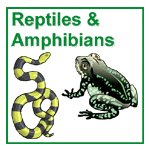 Amphibian Info-File |
| Salamanders, toads, and frogs are all amphibians. Amphibians differ from reptiles in that amphibians spend the first part of their lives in aquatic habitats equipped with gills to breath. Eventually the young grow legs, develop lungs, and breath air. A difference which may help you distinguish between amphibians and reptiles is that amphibians have moist skin, whereas most reptiles have dry, scaly skin. Many salamanders and frogs live in or near ponds, marshes, and lakes. By quietly approaching such habitats and looking carefully at the water's surface, you may spot individuals emerging. Toads, treefrogs, and some salamanders live in upland areas. By looking under logs in a woodland, you may discover them, but be sure to carefully replace logs as they were found. Identify species by color, size, and habitat. It is very important to note that amphibians have sensitive, moist, glandular skin that is easily damaged by human hands. To avoid harming species, make sure your hands are relatively clean and wet before touching amphibians. Another way to enjoy and identify amphibians is through a night walk on your site. Chorus frogs, such as the spring peeco are famous for their night sounds, and the more familiar bullfrog is well-known for its bass notes that say "jug-o'-rum." Children are particularly fascinated by salamanders, toads, and frogs. If possible, include children in your search for amphibians on site. Info-Links
|
 |
| [Search!] | [Survey] [Planning] [Projects] [Outreach] | [What's New!] |
|
Copyright © 1999-2000, REWHC. All Rights Reserved 3212 have visited |
||